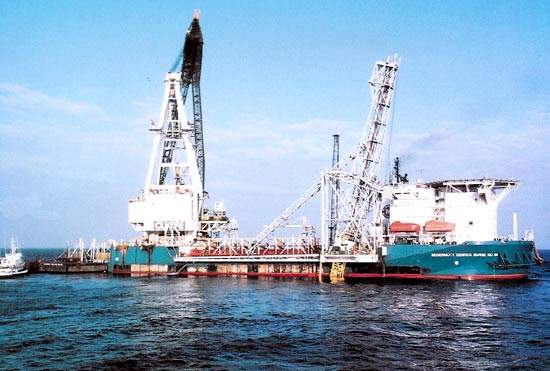Llano is located in the Gulf of Mexico, in Garden Banks blocks 385 and 386, approx. 200 miles southwest of New Orleans in around 2,600ft of water.
Shell, the operator, holds a 27.5% interest in the field. Amerada Hess owns 50% while ExxonMobil has the remaining 22.5%. In May 2002, Shell Exploration & Production Company (SEPCo) acquired Enterprise Oil, making Shell the leaseholder for GB 385 and 386.
The reservoir lies in turbidite sands at depths of approximately 24,000ft subsea in the Pliocene layer and 26,000ft subsea in the Miocene. Located in two zones, the net thickness averages 150ft in the Pliocene and 95ft in the Miocene. The reserves are both oil and gas. API gravity is 28º and sulfur is about 1%. Total gross ultimate recovery for Llano’s initial phase of development is estimated at 40 million barrels of oil equivalent.
LLANO DISCOVERY WELL
After two sidetracks, the discovery well was drilled to measured depth of approximately 27,800ft in 1998 using the Transocean Voyager and Omega. The field came onstream from one well producing 10,500 barrels of oil and 26 million ft³ of gas per day. A second well came onstream at the end of May 2004.
LLANO TIEBACK TO AUGUR TLP
Shell has developed Llano using a subsea system tied back 11.5 miles to its Auger Tension Leg Platform (TLP) on Garden Banks Block 426 in 2,860ft of water. The expandable subsea system will initially consist of two wells tied back to Auger via a pipe-in-pipe looped flow line. Llano is SEPCo’s second project to use 15,000psi subsea equipment.
LLANO PIPELINES AND FLOWLINES
The pipeline network consists of two pipe-in-pipe (PIP) flowlines and a single infield PIP flowline. This comprises an 8.625in-diameter, 1.158in wall thickness API 5L X70 SMLS carrier pipe surrounded by a 12.75in-diameter, 0.5in-thick API 5L X52 HFIW casing pipe. The 8.625in carrier pipe was insulated with a 1.3in-thick jacketed polyurethane foam.
The flowline system includes three PIP flowline initiation sleds located in 2,500ft to 2,620ft of water using pre-installed suction piles located adjacent to the two subsea wells. The installation also includes an infield PIP flowline termination sled and the installation of two 6.625in-diameter, 1.067in-thick API 5L X70 SMLS steel catenary risers (SCRs) located in 2,860ft of water and insulated with 3.5in of Glass Syntactic Polyurethane (GSPU) insulation.
All the installation engineering work was performed by J Ray McDermott Engineering. Specialized installation procedures and tooling were used to allow the outer casing pipe to slide unimpeded over the inner casing pipe during offshore welding and installation operations. Water stop seals and other installation procedures were employed to eliminate moisture of any kind entering the PIP flowline annulus during offshore installation operations.
An SCR installation mast was specially designed for SCR transfer operations between the DB50 and the Auger TLP.
All flowline installation activities were performed by the Derrick Barge No. 50 (DB50) utilizing J-Lay installation methods. All welding work was performed by the JRM Vermatt Bug-N-Band Automatic Welding System (JBBS).
LLANO AUGUR TLP PRODUCTION
Dedicated production capacity at Auger is 25,000 barrels of oil and 75 million ft³ of gas per day. Total development costs have been put at approximately $215 million, including modifications to the Auger TLP. Peak production is expected to reach 32,000 barrels of oil per day.
LLANO CONTRACTORS
J Ray McDermott carried out detailed engineering, subsea, pipeline and marine installation. Other major contractors participating in this development included FMC, V&M, Simrad, Sea Cat and Tenaris.
Bayou Pipe Coating carried out the joint fabrication while Shaw Pipeline Services did the inspection. Fugro Chance carried out surface and acoustic positioning while Oceaneering provided ROV services. Porter Services fabricated the PL sleds.






